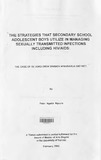| dc.description.abstract | This study was carried out as a population based survey conducted among secondary school boys aged 13 to 19 in 01' J oro-orok division, Nyandarua District. The objectives of the study were: to investigate the factors that influence adolescent boys' sexual behaviours and practices; explore the role of sexual perceptions and attitudes on boys' risk management practices; identify the various risk management techniques that boys employ against the risks of STI and HIV infection and to examine boys' illness and treatment seeking behaviours upon infection with an STI. The research was carried out in May and June 1997. The study presents the findings from
120 adolescent boys who filled the survey questionnaires as well as 54 others who provided supplementary qualitative data as FGD participants and key informants. Stratified and random sampling procedures were used in the selection of the respondents while purposive sampling was used to select the FGD participants and key informants. The data was analyzed using quantitative and qualitative methods.
The findings revealed that individual and family background characteristics, peer group associations and the male sexual norms prevailing in the respondents' communities did influence the boys' sexual behaviours and practices.
The adolescent boys were found to have sexual attitudes and opinions that were not compatible with wholesome sexual and reproductive health and practice. Most of the respondents had a non-accepting attitude towards condom use, while significant proportions approved multiple sexual partner relationships, casual sex, rape and premarital sexual intercourse for boys. The results of the study showed that these negative sexual attitudes and opinions hindered adoles cent boys from adopting effective risk management or safer sex practices. The study also noted that while the boys reported using various strategies in managing the risks of STI and HIV infection, they mainly depended on lay techniques and resources that offered them little or no protection.
Finally, the results of the study showed that adolescent boys have generally poor STI illness and treatment-seeking behaviours. A substantial proportion of those with STI experience ignored or did nothing about their symptoms while the majority of those who sought some kind of treatment only did so after lengthy delays (between 14 to 21 days). Moreover, of those who sought STI treatment most depended on self-medication, mainly herbal regimens and OTe drugs. Lack of money, embarrassment, adult hostility and physical distance mainly constrained boys from accessing STI treatment when they felt they needed it.
The study recommends that STI and HIV prevention and control intervention programmes tar getting young people should not only aim at changing their sexual behaviours but also their faulty attitudes which are precedents to risky practices. Further, for AIDS information, to trans late into modified sexual behaviours, programmes need to present the information in ways that are attractive and acceptable to adolescents. Involving the adolescents in programme design, delivery and evaluation is one effective way, that could also lead to positive peer pressure in modified sexual behaviour change. | en |

